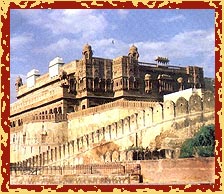Rajasthan Travels ::
Rajasthan Fort & Palaces ::
Junagarh Fort, Bikaner
Junagarh Fort, Bikaner

One of the most imposing forts of Northern India-- Junagarh Fort has remained unconquered till date. This fort was built in 15th century by one of the most able and trusted generals of Akbar, Raja Rai Singh.
A high wall and deep moats surround the fort. The 37 bastions guard the fort and only two gates provide the access inside the fort. The Suraj Pol or the Sun Gate is the main entrance to the fort. The Junagarh Fort has defied all the attacks except for the brief stint by Kamaran who captured the fort but was unable to retain his victory more than 24 hours.
Inside the fort is a profusion of 37 palaces, temples and pavilions that are marvels in red sandstone construction. The palaces have exquisitely carved windows, balconies, towers and kiosks. The mirrors, paintings and carved marble panels in the Moon Palace are a treat for eyes. The Phool Mahal or Flower Palace was adorned with glasses and mirrors. The victory over Aurangzeb was celebrated by building the Karan Mahal.
The multi-storeyed Anup Mahal was the governance chambers for the rulers. The beautifully maintained rooms now display the treasures of the Royal family. Also worth visiting are the Ganga Niwas, Dungar Niwas, Vijai Mahal, and Rang Mahal. The fort museum has an extensive collection of illuminated manuscripts, jewellery, jars and carpets, arms and weapons, treaties, decorations and the 'Farmans'.
This fort and it's palaces were built between 1588-1593 by raja Raj Singh, a general in the army of the Mughal emperor Akbar. It has a 96 mt long wall, with 37 bastions and 2 entrances. The main entrance of the fort is Suraj pol or sun gate.
The fort encompasses many palaces amongst which the most spectacular ones are the Chandra Mahal or Moon palace, the Phool Mahal or Flower palace, both ornated with carved panels and mirrors and the Karan Mahal.
Karan Mahal was built in remembrance of the celebration of the grand victory over Aurangzeb. Durga Niwas, a fabulously painted courtyard and Ganga Niwas which housed a finely carved red sandstone front, are the other places of attraction in this fort.


 One of the most imposing forts of Northern India-- Junagarh Fort has remained unconquered till date. This fort was built in 15th century by one of the most able and trusted generals of Akbar, Raja Rai Singh.
One of the most imposing forts of Northern India-- Junagarh Fort has remained unconquered till date. This fort was built in 15th century by one of the most able and trusted generals of Akbar, Raja Rai Singh.